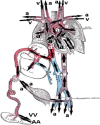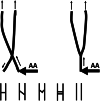Hypothesized pathogenesis of acardius acephalus, acormus, amorphus, anceps, acardiac edema, single umbilical artery, and pump twin risk prediction
- PMID: 34931489
- PMCID: PMC9299632
- DOI: 10.1002/bdr2.1976
Hypothesized pathogenesis of acardius acephalus, acormus, amorphus, anceps, acardiac edema, single umbilical artery, and pump twin risk prediction
Abstract
Background: Acardiac twinning complicates monochorionic twin pregnancies in ≈2.6%, in which arterioarterial (AA) and venovenous placental anastomoses cause a reverse circulation between prepump and preacardiac embryos and cessation of cardiac function in the preacardiac. Literature suggested four acardiac body morphologies in which select (groups of) organs fail to develop, deteriorate, or become abnormal: acephalus (≈64%, [almost] no head, part of body, legs), amorphus (≈22%, amorphous tissue lump), anceps (≈10%, cranial bones, well-developed), and acormus (≈4%, head only). We sought to develop hypotheses that could explain acardiac pathogenesis, its progression, and develop methods for clinical testing.
Methods: We used qualitatively described pathophysiology during development, including twin-specific AA and Hyrtl's anastomoses, the short umbilical cord syndrome, high capillary permeability, properties of spontaneous aborted embryos, and Pump/Acardiac umbilical venous diameter (UVD) ratios.
Results: We propose that each body morphology has a specific pathophysiologic pathway. An acephalus acardius may be larger than an anceps, verifiable from UVD ratio measurements. A single umbilical artery develops when one artery, unconnected to the AA, vanishes due to flow reduction by Hyrtl's anastomotic resistance. Acardiac edema may result from acardiac body hypoxemia combined with physiological high fetal capillary permeability, high interstitial compliance and low albumin synthesis. Morphological changes may occur after acardiac onset. Pump twin risk follows from UVD ratios.
Conclusion: Our suggested outcomes agree reasonably well with reported onset, incidence, and progression of acardiac morphologies. Guidance for clinical prediction and testing requires ultrasound anatomy/circulation study, from the first trimester onward.
Keywords: Hyrtl's anastomosis; acardiac monochorionic twins; acardiac morphology; short umbilical cord syndrome; spontaneous aborted embryos.
© 2021 The Authors. Birth Defects Research published by Wiley Periodicals LLC.
Conflict of interest statement
The authors declare no conflict of interests.
Figures




Similar articles
-
Hypothesis acardiac twin pregnancies: Pathophysiology-based hypotheses suggest risk prediction by pump/acardiac umbilical venous diameter ratios.Birth Defects Res A Clin Mol Teratol. 2016 Feb;106(2):114-21. doi: 10.1002/bdra.23467. Epub 2015 Dec 21. Birth Defects Res A Clin Mol Teratol. 2016. PMID: 26689996
-
Acardiac twin pregnancies part III: Model simulations.Birth Defects Res A Clin Mol Teratol. 2016 Dec;106(12):1008-1015. doi: 10.1002/bdra.23559. Epub 2016 Sep 15. Birth Defects Res A Clin Mol Teratol. 2016. PMID: 27629527
-
Acardiac twin pregnancies part IV: Acardiac onset from unequal embryonic splitting simulated by a fetoplacental resistance model.Birth Defects Res. 2017 Feb 15;109(3):211-223. doi: 10.1002/bdra.23581. Birth Defects Res. 2017. PMID: 27891739
-
Twin-reversed arterial perfusion (TRAP) sequence: case reports and review of literature.Aust N Z J Obstet Gynaecol. 1997 May;37(2):187-91. doi: 10.1111/j.1479-828x.1997.tb02251.x. Aust N Z J Obstet Gynaecol. 1997. PMID: 9222465 Review.
-
Modeling acardiac twin pregnancies.Ann N Y Acad Sci. 2007 Apr;1101:235-49. doi: 10.1196/annals.1389.023. Epub 2007 Mar 7. Ann N Y Acad Sci. 2007. PMID: 17344539 Review.
Cited by
-
Twin Acardiac: Case Reported From Ethiopia.Clin Case Rep. 2025 Mar 27;13(4):e70379. doi: 10.1002/ccr3.70379. eCollection 2025 Apr. Clin Case Rep. 2025. PMID: 40161034 Free PMC article.
-
Fetal magnetic resonance imaging, ultrasound, and echocardiography findings in twin reversed arterial perfusion sequence.Pediatr Radiol. 2024 May;54(5):702-714. doi: 10.1007/s00247-024-05879-8. Epub 2024 Mar 15. Pediatr Radiol. 2024. PMID: 38488924
-
Fetal brain injury in the pump twin of a TRAP sequence with favorable postnatal outcome: a case report.BMC Pregnancy Childbirth. 2025 Jul 3;25(1):705. doi: 10.1186/s12884-025-07825-4. BMC Pregnancy Childbirth. 2025. PMID: 40610929 Free PMC article.
References
-
- Abi‐Nader, K. , Whitten, S. M. , Filippi, E. , Scott, R. , & Jauniaux, E. (2009). Dichorionic triamniotic triplet pregnancy complicated by acardius acormus. Fetal Diagnosis and Therapy, 26, 45–49. - PubMed
-
- Alves, J. A. G. , Brasileiro, J. M. F. , de Aquino Campos, A. P. , & Pitombeira Ferreira, M. V. (1998). Diagnóstico pré‐natal de um gêmeo hemiacárdico: Relato de caso. Revista Brasileira de Ginecologia e Obstetrícia, 20(2), 111–113.
-
- Benedetti, A. (1533). De morborum a capitae ad pedis signis. Habes Lector Studiose Hoc Voluminae. Venice: Lucae Antonij Juntae.
-
- Benirschke, K. (2009). The monozygotic twinning process, the twin‐twin transfusion syndrome and acardiac twins. Placenta, 30, 923–928. - PubMed
-
- Benirschke, K. , & Kim, C. K. (1973). Multiple pregnancy. The New England Journal of Medicine, 288(24), 1276–1284. - PubMed
MeSH terms
LinkOut - more resources
Full Text Sources
Medical

